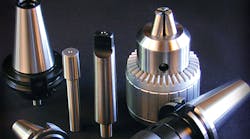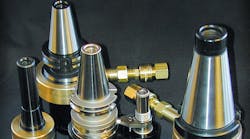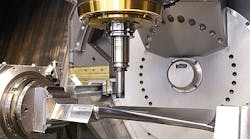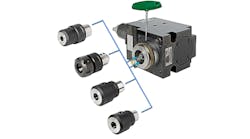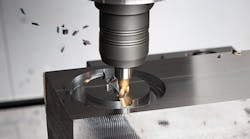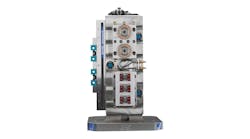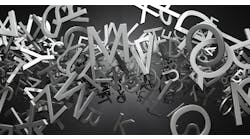For many machinists, the conversation begins, “If I could have this size tool with this attachment on it, we'd be able to …”. With the variety of machine taper types, sizes, differences in the flanges, draw-in thread sizes, and pull studs, finding the ideal toolholder for the job can be a difficult task.
Yet in many cases, if machinists want to make adjustments in dimensions, quick-change tooling or other options can reduce set-up times and speed production of machined components. This can be as simple as extending the tool length so the path of travel to the workpiece is minimized, or setting up all tools for quick change-outs.
Inevitably this leads to long, exhaustive searches of catalogs or online forums. Failing to find what they need, some machinists purchase ‘blanks’ and grind them down to meet the precise requirements of their operation.
However, some manufacturers, particularly smaller, more nimble, U.S.-based operations, are willing to create specialty toolholders.
“Many of the larger manufacturers don’t want to spend time setting up a machine just to create five pieces,” explained Paul Gassman of Collis Toolholder Corp., a company that manufactures and distributes over 4,500 SKUs of toolholders. “And, it is not just one machine; it might take 14 setups to make one part.”
Quotable variables — For Stephee Thee of Vallen Industrial Distribution, when companies call or e-mail her for ‘specials’ there are very few options available. “A lot of vendors come back with a ‘no-quote’ or an astronomical price,” she said. She credited Collis for quoting reasonable price, for example, for variations like varying lengths and conversions, a Morse taper (either stepped or up reduced in size), a V-flange shank with a quick-change nose, or an extended projection for deep-hole drilling and tapping.
According to Gassman, just about any toolholder can be produced based on special requirements or proprietary dimensions, in just about any combination of shank, collar, and collet. Furthermore, just about any system can be converted into a quick-tool-change format. Adjustable adapter and tap extensions are also available.
This can be a simple matter of mixing and matching options already in a catalogue. If an appropriate toolholder cannot be located, a replacement can be machined by those with the in-house capability using CAD software to adjust for varying projection lengths.
“You can basically combine any shank and holder together and extend the dimensions in any direction, and our software program will recover all the dimensions on the tool so it isn't like drawing everything from scratch,” Gassman said.
Quality domestic manufacturers also have more expertise achieving the precise tolerances for optimal fit and concentricity. By using options with superior fit and better balance, more accurate work and better surface finishes can be achieved while extending the life of the equipment itself.
For all its tapered toolholders, Collis is known for exceeding the industry “AT” standards for precise fit in the spindle. These standards are a specification of ANSI/ASME standard (ASME B5.50-2009), and indicate the tolerances that must be met in relation to the taper angle. Collis uses one-half the allowable tolerance of this standard.
For high-speed machining above 10,000 RPM, the toolholder also must be balanced more precisely or vibration can occur, leading to out-of-tolerance parts. For these reasons, Collis machine-tool spindles and machine-tool parts usually are specified with vibration levels of G2.5, whereas others offer only G6.3. Although the toolholders are custom manufactured, Gassman said this does not have to mean long lead-times.
“Machine operators don’t order a toolholder far in advance for a project. They are basically getting ready to run some parts and need the toolholder sooner, rather than later, so lead-time is a factor,” Gassman added, noting that Collis can deliver a custom machined toolholder in as little as two weeks.
Quick-tool-change, adapters, and extensions — Various adjustments also can be made that do not require a custom-manufactured toolholder. This may include quick-tool-change tools, adjustable adapters and tap extenders for all taper types. “With 4,500 options, there is a vast amount of tooling options without ever making it a special just by combining some of the standard options with existing holders,” Gassman said.
Modular, quick-change tooling systems provide a single interface for multiple types of machines. Collis offers the Rapid Switch line that is interchangeable with Universal’s Kwik Switch taper types.
Adjustable adapters and tap extensions also can increase the projection dimensions of a tool up to several inches, and are adjustable to 1-2 in., depending on the diameter of the shank. These tools are extremely precise, with a shank tolerance of 0.0003 in. With the industry standard bushing tolerance of 0.0005 in. on the inside bore and outside surface, for 0.001 in. total clearance. This minimizes any possible vibration or fretting.
Hard-to-find toolholders — In some cases, a tool for an older piece of equipment may exist but is just difficult to find. Collis is continuing to supply tools for machining operations that have been around for a long time and still operate drill presses, manual milling machines, and automotive transfer line equipment, along with newer CNC machines.
In these cases, the toolholder may be available from a provider that offers a broad catalogue of options. Collis, for example, continues to offer hard-to-find toolholders for automotive transfer lines and Rapid Switch milling machines.
Unique options for drill presses are also available, including “Magic Chucks” that provide a way to turn a single spindle machine into a multi-operation machine.
